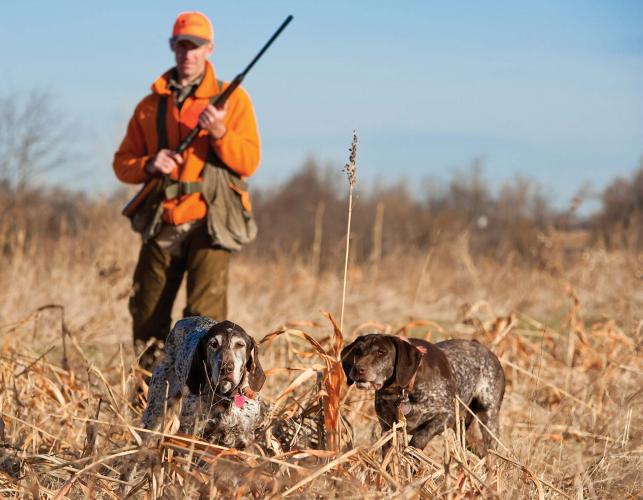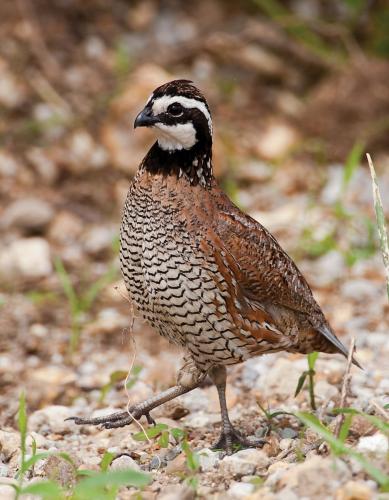“Got a point over here!” your buddy yells. You round a bend and see, at the edge of a thick patch of woods, your friend’s pointer, stone still and tail high. A good shot is going to be tough. The angle of the pointer’s head indicates the quail are in a mass of wild plum, overhung by tree limbs and saplings. When the birds flush, they will likely fly deeper into the woods.
You walk in to flush the quail while your friend watches for birds along the edge. You lean over to avoid some low-hanging tree limbs, and that’s when the covey of 20 birds flushes in a whir of brown wings. You try to put shotgun to shoulder, but a limb grabs your left arm. By the time you shake yourself free, the birds are gone. Your buddy makes three shots as the entire covey flies deeper into the woods. He connects on two oak trees and a hickory sapling.
That’s quail hunting — often tough and sometimes frustrating. But when it comes together: a stylish point, a fine shot, a bird brought to hand by a well-trained dog — it’s hunting at its best. If you haven’t tried quail hunting, here’s what it takes.
Knowledge of the Bird
Missouri’s northern bobwhite quail have very specific habitat requirements. They thrive where the ground has been disturbed. Some fields of grain crops meet this requirement, as do fields that have been disked or burned and allowed to grow in native plants. These fields provide food for quail in the form of seeds and bugs, and open ground that allows young quail to walk around easily. The birds prefer small fields, ideally less than 20 acres, laced with brushy draws and surrounded by patches of woods, which offer quail places to rest, nest, and escape predators. There should also be roosting fields of knee-high vegetation, with little or no woody cover, nearby. If any of this variety is missing, an area will have few, if any, quail.
As with habitat, the daily habits of bobwhite are predictable. In fall, bobwhite form into groups called coveys. The number of birds in a covey is commonly 10 to 12 and can be as many as 30. In late evening, quail move to their roosting fields and arrange themselves in a tight bunch, tail to tail. This behavior helps quail conserve heat on cold nights. By roosting in open fields, if disturbed by a predator at night, they can quickly flush without the chance of flying into overhead brush and limbs.
At first light, on clear, still mornings, quail often call from the roost. Depending on conditions, they then either fly or walk to an area where they feed. In harvested crop fields, such as corn, soybeans, or milo, quail quickly fill their crops with waste grain, at which time they move to brushy or wooded areas close by where they dust their feathers and loaf. Again, depending on conditions, quail move from protective cover in the afternoon to feed again before going to roost. If available, quail will drink standing water, but they can get all the water they need from drinking dew and using the water their bodies make when they digest food.
Gear
The equipment needed for quail hunting is fairly simple. You need a shotgun that is equipped with an open choke (cylinder, skeet, or improved cylinder). With birds flushing near you, quail shots are typically close, and you will need as wide a shot pattern as possible. Number 7½ or 8 shot is right for quail. It also pays to shoot as heavy a field load as you can find for your shotgun, which will give you a denser pattern along with the wide pattern of open chokes.
Quail hunting involves lots of walking, so invest in a high-quality pair of hunting boots. With all the walking, it’s also important to dress appropriately. That means go light. If you bundle up as you would for a cold day on the deer stand, you will end up sweat-soaked. With a little experience, you will find what’s comfortable for you.
A light game vest to carry your birds and shells will have enough pocket space for water and snacks. Buy one in hunter orange, so your hunting buddies and other hunters can see you. A hunter orange cap is a must, too. Sometimes all that is visible of a quail hunter is the top of his head as he makes his way through high cover.
Brush pants, designed to turn thorns, or a pair of chaps designed for the same purpose are another must when quail hunting. Hunts often require walking through briars. If you wear jeans, quail hunting will be a painful experience.
Bird Dogs
Memorable quail hunts can hinge on good bird dogs. There are many breeds, from English pointers to pointing labs. The key is getting a dog out of a line that is intelligent, is bold, has a strong instinct to hunt, has a superior nose, and is eager to please. If you buy a puppy, how do you know if it has these qualities? Look to its parents. If they hold these traits, chances are good the pup will have them, too.
Another consideration with bird dogs is how far they range while hunting for quail. Some bird dogs have been bred to range out, often several hundred yards, in search of quail. This works fine if you hunt on horseback, but most quail hunters hunt on foot and prefer dogs that hunt closer. How can you know the range of a dog when you buy it as a pup? Again, look to the parents. If they hunt close, chances are their pups will, too.
Some hunters pay a professional to train their bird dogs, but this is expensive, and you miss the joy of watching a pup learn. Moreover, if you don’t understand how a dog is trained, you could reverse all the training by unwittingly mishandling your dog.
Training a bird dog is not that difficult. The first step is simply taking the pup out and letting it run and explore. This builds the pup’s hunting instincts and confidence. You do this for six months to a year, depending on the pup. You give no commands. Just let the pup play.
Formal training that follows involves three basic skills: sensitivity to a dog’s temperament, proper timing of corrections, and repetition.
Some dogs are bold and take corrections well. Others are more timid and require more gentle, and/or slower training. A timid dog can be ruined by training methods that are too forceful. On the other hand, a bold, dominant dog may require firm training. Professional trainers refer to this as “reading” a dog — figuring a dog’s temperament and training accordingly.
Proper timing of corrections involves making them immediately after a dog makes a mistake. Research indicates that if as few as 10 seconds pass before a correction is made, a dog has difficulty understanding what it did wrong. A classic example: If a dog does not come in when you call it, you don’t reprimand it when it finally does come to you because the dog will think it is being punished for coming to you.
The third point, repetition, is just that — repeating what has been learned until a dog’s response becomes a conditioned response, automatic.
An excellent reference on details concerning training bird dogs is Best Way to Train Your Gun Dog: The Delmar Smith Method, by the late Bill Tarrant. The book gives all the details you need to know concerning how to turn a pup into a skilled bird dog.
Hunting Strategy
As always, the key to successful hunting is being where the game is. If you have ground that supports quail, and you have a bird dog that has been trained to find quail, hold points, come when called, and retrieve downed quail, you are in business. The hunting is simple. Put your dog on the ground and follow it. It is amazing how many quail hunters fail to do this. They spend much of a hunt blowing their whistle and giving their dog directions. Big mistake. Those hunters end up with a distracted dog. The dog’s job is to find birds. Give it the freedom to do so.
Once you find quail, it’s time for decisions. If a covey holds 15 birds or more, you should only take a few birds, but then leave the rest for next year’s breeding stock. Leaving enough birds in a covey also helps ensure that there are enough birds to bunch up and stay warm on a cold winter night.
If the ground is frozen hard on a day you plan to quail hunt, wait until midmorning so the ground has a chance to soften up. Frozen ground can injure a bird dog’s feet. Moreover, quail season is more than two months long. Bird dogs, like athletes, can suffer injuries from too much exertion. A two- to three-hour hunt is about right for a bird dog, particularly if it is hunted several days in a row. Make sure you feed your hunting partner quality dog food. If your dog shows signs of weight loss and stiffness, take a few days off. Serious quail hunters often own several dogs, so while resting one dog, they can hunt another. Yes, quail hunting can become an obsession; it’s that much fun. Bird dogs, like athletes, can suffer injuries from too much exertion. A two- to three-hour hunt is about right for a bird dog, particularly if it is hunted several days in a row.
Cleaning and Cooking
Quail are easy to clean. With poultry shears or a knife, cut off the wings, head, and feet. Starting at the head end, peel the skin and feathers down and off the carcass. Again, with poultry shears or a knife, cut all the way up the center of the back by starting at the vent and cutting upward. Open the back and remove the entrails. On a cutting board, lay the carcass on its back and with a sharp knife, cut down the center of the breast, lengthwise, along the breastbone or sternum. With poultry shears or scissors, finish separating the carcass into two halves by cutting through the bottom of the breastbone.
Clean each half carefully in cold water. Next to the ribs, thumb out the lungs that adhere there. At the top of each thigh, thumb out the kidneys. If any edible portions of the quail are bloodied or damaged by shot, trim off liberally. This leaves quail ready to cook.
Quail halves cook quickly and are great for frying or grilling.
To grill, season quail halves with your favorite dry rub or marinade. Place quail on a grill heated to medium high and grill for four or five minutes a side.
To fry, soak quail halves in milk, then coat with all-purpose flour well seasoned with seasoning salt and a little black pepper. Pan fry in one-third inch of canola oil, heated to 350 degrees, for seven to eight minutes on one side, and five or six minutes on the other side, or until both sides are browned. Drain on paper towels before serving.
Learn more about hunting quail and other upland game birds at mdc.mo.gov/node/3607. For more on quail management, visit mdc.mo.gov/node/3607.












Also In This Issue


And More...
This Issue's Staff
Managing Editor - Nichole LeClair Terrill
Art Director - Cliff White
Staff Writer - Jim Low
Photographer - Noppadol Paothong
Photographer - David Stonner
Designer - Stephanie Thurber
Artist - Mark Raithel
Circulation - Laura Scheuler






















